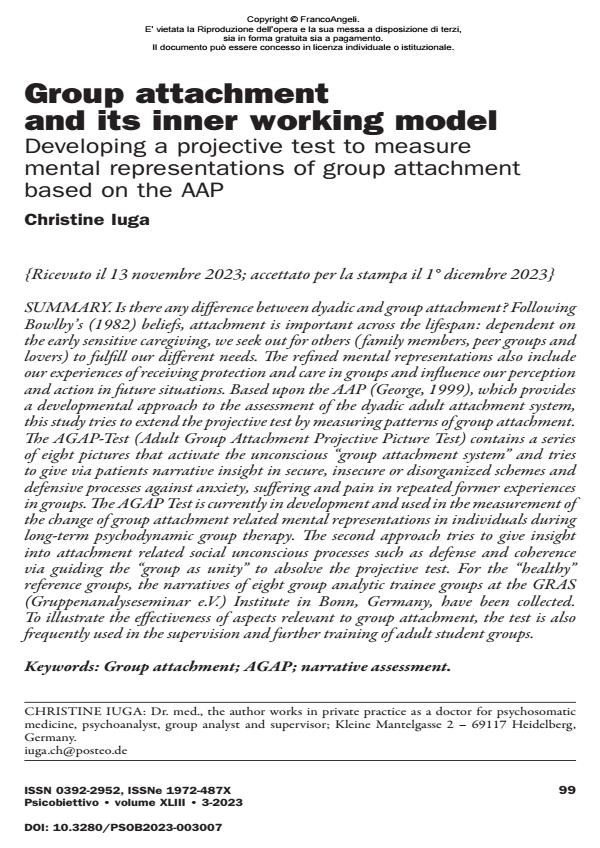Group attachment and its inner working model Developing a projective test to measure mental representations of group attachment based on the AAP
Titolo Rivista PSICOBIETTIVO
Autori/Curatori Christine Iuga
Anno di pubblicazione 2024 Fascicolo 2023/3
Lingua Inglese Numero pagine 15 P. 99-113 Dimensione file 680 KB
DOI 10.3280/PSOB2023-003007
Il DOI è il codice a barre della proprietà intellettuale: per saperne di più
clicca qui
Qui sotto puoi vedere in anteprima la prima pagina di questo articolo.
Se questo articolo ti interessa, lo puoi acquistare (e scaricare in formato pdf) seguendo le facili indicazioni per acquistare il download credit. Acquista Download Credits per scaricare questo Articolo in formato PDF

FrancoAngeli è membro della Publishers International Linking Association, Inc (PILA)associazione indipendente e non profit per facilitare (attraverso i servizi tecnologici implementati da CrossRef.org) l’accesso degli studiosi ai contenuti digitali nelle pubblicazioni professionali e scientifiche
Is there any difference between dyadic and group attachment? Following Bowlby’s (1982) beliefs, attachment is important across the lifespan: dependent on the early sensitive caregiving, we seek out for others ( family members, peer groups and lovers) to fulfill our different needs. The refined mental representations also include our experiences of receiving protection and care in groups and influence our perception and action in future situations. Based upon the AAP (George, 1999), which provides a developmental approach to the assessment of the dyadic adult attachment system, this study tries to extend the projective test by measuring patterns of group attachment. The AGAP-Test (Adult Group Attachment Projective Picture Test) contains a series of eight pictures that activate the unconscious “group attachment system” and tries to give via patients narrative insight in secure, insecure or disorganized schemes and defensive processes against anxiety, suffering and pain in repeated former experiences in groups. The AGAP Test is currently in development and used in the measurement of the change of group attachment related mental representations in individuals during long-term psychodynamic group therapy. The second approach tries to give insight into attachment related social unconscious processes such as defense and coherence via guiding the “group as unity” to absolve the projective test. For the “healthy” reference groups, the narratives of eight group analytic trainee groups at the GRAS (Gruppenanalyseseminar e.V.) Institute in Bonn, Germany, have been collected. To illustrate the effectiveness of aspects relevant to group attachment, the test is also frequently used in the supervision and further training of adult student groups.
Ci sono delle differenze tra attaccamento diadico e attaccamento di gruppo? Seguendo il lavoro di Bowlby (1982), l’attaccamento è importante per tutta la durata della vita e a seconda del caregiving precoce, cerchiamo gli altri (membri della famiglia, gruppi di pari, persone da amare) per soddisfare i nostri diversi bisogni. L’approfondimento delle rappresentazioni mentali propone l’inclusione anche delle nostre esperienze di protezione e cura in gruppo e insieme influenzano la nostra percezione e azione nelle situazioni future. Sulla base dell’AAP (George, 1999), che fornisce un approccio evolutivo alla valutazione del sistema di attaccamento diadico dell’adulto, il presente studio cerca di estendere il test proiettivo misurando i modelli di attaccamento di gruppo. L’AGAPTest (Adult Group Attachment Projective Picture Test) contiene una serie di otto immagini che attivano il “sistema di attaccamento di gruppo” inconscio e cerca di fornire ai pazienti una visione narrativa di schemi sicuri, insicuri o disorganizzati e processi difensivi contro l’ansia, la sofferenza e il dolore in ripetute esperienze precedenti di gruppo. Il test AGAP è attualmente in fase di sviluppo e utilizzato nella misurazione del cambiamento delle rappresentazioni mentali legate all’attaccamento di gruppo negli individui durante la terapia psicodinamica di gruppo a lungo termine. Il secondo strumento cerca di dare un’idea dei processi sociali inconsci legati all’attaccamento, come la difesa e la coerenza, guidando il “gruppo come unità” per assolvere il test proiettivo. Per i gruppi di riferimento “sani”, le narrazioni di otto gruppi di tirocinanti analitici di gruppo al GRAS (Gruppenanalyseseminar e.V.) dell’Istituto di Bonn, in Germania. Per illustrare l’efficacia degli aspetti rilevanti per l’attaccamento di gruppo, il test viene spesso utilizzato anche nella supervisione e nella formazione continua di gruppi di studenti adulti.
Parole chiave:Attaccamento di gruppo; AGAP; Assessment narrativo.
Christine Iuga, Group attachment and its inner working model Developing a projective test to measure mental representations of group attachment based on the AAP in "PSICOBIETTIVO" 3/2023, pp 99-113, DOI: 10.3280/PSOB2023-003007